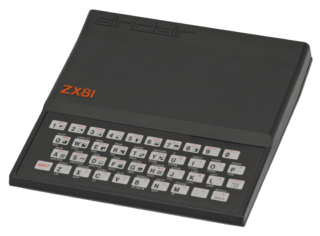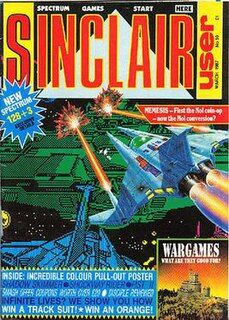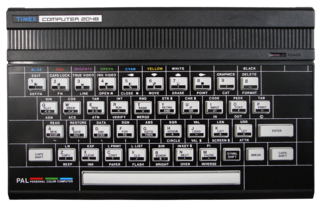
The ZX Spectrum is an 8-bit personal home computer released in the United Kingdom in 1982 by Sinclair Research.

The ZX81 is a home computer that was produced by Sinclair Research and manufactured in Dundee, Scotland by Timex Corporation. It was launched in the United Kingdom in March 1981 as the successor to Sinclair's ZX80 and was designed to be a low-cost introduction to home computing for the general public. It was hugely successful, and more than 1.5 million units were sold before it was discontinued. The ZX81 found commercial success in many other countries, notably the United States where it was initially sold as the ZX-81. Timex manufactured and distributed it under licence and enjoyed a substantial but brief boom in sales. Timex later produced its own versions of the ZX81 for the US market: the Timex Sinclair 1000 and Timex Sinclair 1500. Unauthorized clones of the ZX81 were produced in several countries.
Sinclair BASIC is a dialect of the programming language BASIC used in the 8-bit home computers from Sinclair Research and Timex Sinclair. The Sinclair BASIC interpreter was made by Nine Tiles Networks Ltd.

The Timex Sinclair 1000 (TS1000) was the first computer produced by Timex Sinclair, a joint venture between Timex Corporation and Sinclair Research. It was launched in July 1982, with a US sales price of US$99.95, making it the cheapest home computer at the time; it was advertised as "the first computer under $100". The computer was aimed at regular home users. Unlike earlier computers aimed at home users, the TS1000 was not a kit which had to be soldered and assembled. As purchased, the TS1000 was fully assembled and ready to be plugged into the users' home TV. The TS1000 was a slightly-modified version of the Sinclair ZX81 with an NTSC RF modulator, designed for use with North American TVs, instead of the UK PAL RF modulator which was used for units sold in Portugal. The TS1000 doubled the onboard RAM from 1 KB to 2 KB. The TS1000's casing had slightly more internal shielding but remained the same as Sinclair's, including the membrane keyboard. It had black-and-white graphics and no sound. It was followed by an improved version, the Timex Sinclair 1500 which had substantially more RAM and a lower price (US$80). However, the TS1500 did not achieve market success, given that the marketplace was by this time dominated by Commodore, RadioShack, Atari and Apple.

The Timex Sinclair 2068 (TS2068), released in November 1983, was Timex Sinclair's fourth and last home computer for the United States market. It was also marketed in Argentina, Portugal and Poland, as the Timex Computer 2068.
Timex Group USA, Inc. is an American manufacturing company founded in 1854. The company is now a wholly owned subsidiary of the Dutch conglomerate Timex Group B.V..
Sinclair Research Ltd is a British consumer electronics company founded by Clive Sinclair in Cambridge. It was originally incorporated in 1973 as Westminster Mail Order Ltd, renamed Sinclair Instrument Ltd, then Science of Cambridge Ltd, then Sinclair Computers Ltd, and finally Sinclair Research Ltd. It remained dormant until 1976, when it was activated with the intention of continuing Sinclair's commercial work from his earlier company Sinclair Radionics, and adopted the name Sinclair Research in 1981.

Sinclair User, often abbreviated SU, was a magazine dedicated to the Sinclair Research range of home computers, most specifically the ZX Spectrum. Initially published by ECC Publications, and later EMAP, it was published in the UK between 1982 and 1993, and was the longest running Sinclair-based magazine.

The Timex FDD 3000 was a nearly complete computer by Timex of Portugal. It began its development at Timex Computer Corporation in the U.S., but it was at Timex of Portugal that the work was finished.
The Timex Strike was a major industrial dispute which took place in Dundee, Scotland in 1993. The dispute, which was notable for its level of picket-line violence resulted in the closure of the Timex plant in the city after 47 years.

Timex Datalink or Timex Data Link is a line of early smartwatches manufactured by Timex and is considered a wristwatch computer. It is the first watch capable of downloading information from a computer. As the name implies, datalink watches are capable of data transfer through linking with a computer. The Datalink line was introduced in 1994 and it was co-developed with Microsoft as a wearable alternative to mainstream PDAs with additional attributes such as water resistance, that PDAs lacked, and easy programmability. The watch was demonstrated by Bill Gates on 21 June 1994 in a presentation where he downloaded information from a computer monitor using bars of light and then showed to the audience the downloaded appointments and other data. The early models included models 50, 70, 150 and model 150s. The model numbers indicated the approximate number of phone numbers that could be stored in the watch memory. These early models were, at the time of their introduction, the only watches to bear the Microsoft logo. The watches have been certified by NASA for space travel and have been used by astronauts and cosmonauts in space missions. There had been an evolution over the years as to the number and type of entries that can be stored in the various watch models as well as the mode of data transfer between computer and watch. At the time of its introduction the watch was considered high-tech.

The Unipolbrit Komputer 2086 was a Polish version of the home computer Timex Sinclair 2068, produced by a joint venture of the Polish Unimor and Timex Computer of Portugal. The machine wasn't 100% ZX Spectrum-compatible and a "Spectrum Emulation" cartridge was available.
The Timex Sinclair 2050 (TS2050) was a computer modem built by Westridge for Timex Computer Corp. Very few were sold with Timex Sinclair label, most with the designed Timex case was sold with the label Westridge 2050 because Timex exited the computer market when the modem started to be manufactured. A lot of people bought the modem board and made custom casing.
Because it was very slow (300bit/s), a magazine published a way to modify the modem to convert it to a serial port, allowing users to connect faster modems.
A cassette was released with the modem with software for TS1000/TS1500 on side A and for TS2068 on side B, to control it.
Timex Group B.V., or Timex Group, is a Dutch holding company headquartered in Hoofddorp, the Netherlands. It is the corporate parent of several global watchmaking companies including Timex Group USA, Inc., TMX Philippines, Inc., and Timex Group India Ltd.

2048 is a single-player sliding block puzzle game designed by Italian web developer Gabriele Cirulli. The game's objective is to slide numbered tiles on a grid to combine them to create a tile with the number 2048. However, one can continue to play the game after reaching the goal, creating tiles with larger numbers.
The TC 3256 or Timex Computer 3256 was a computer created by Timex of Portugal, a branch of Timex Corporation.









